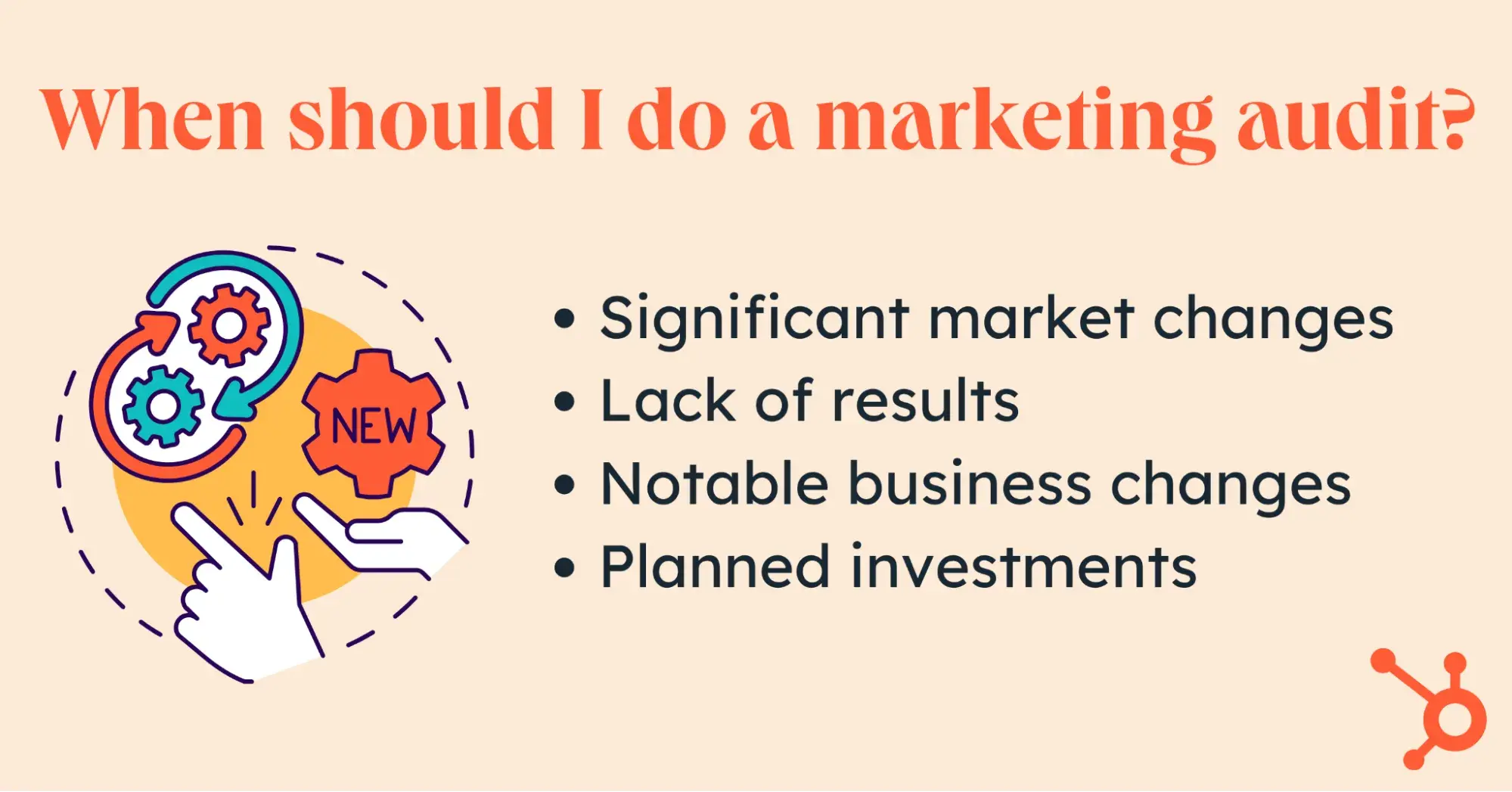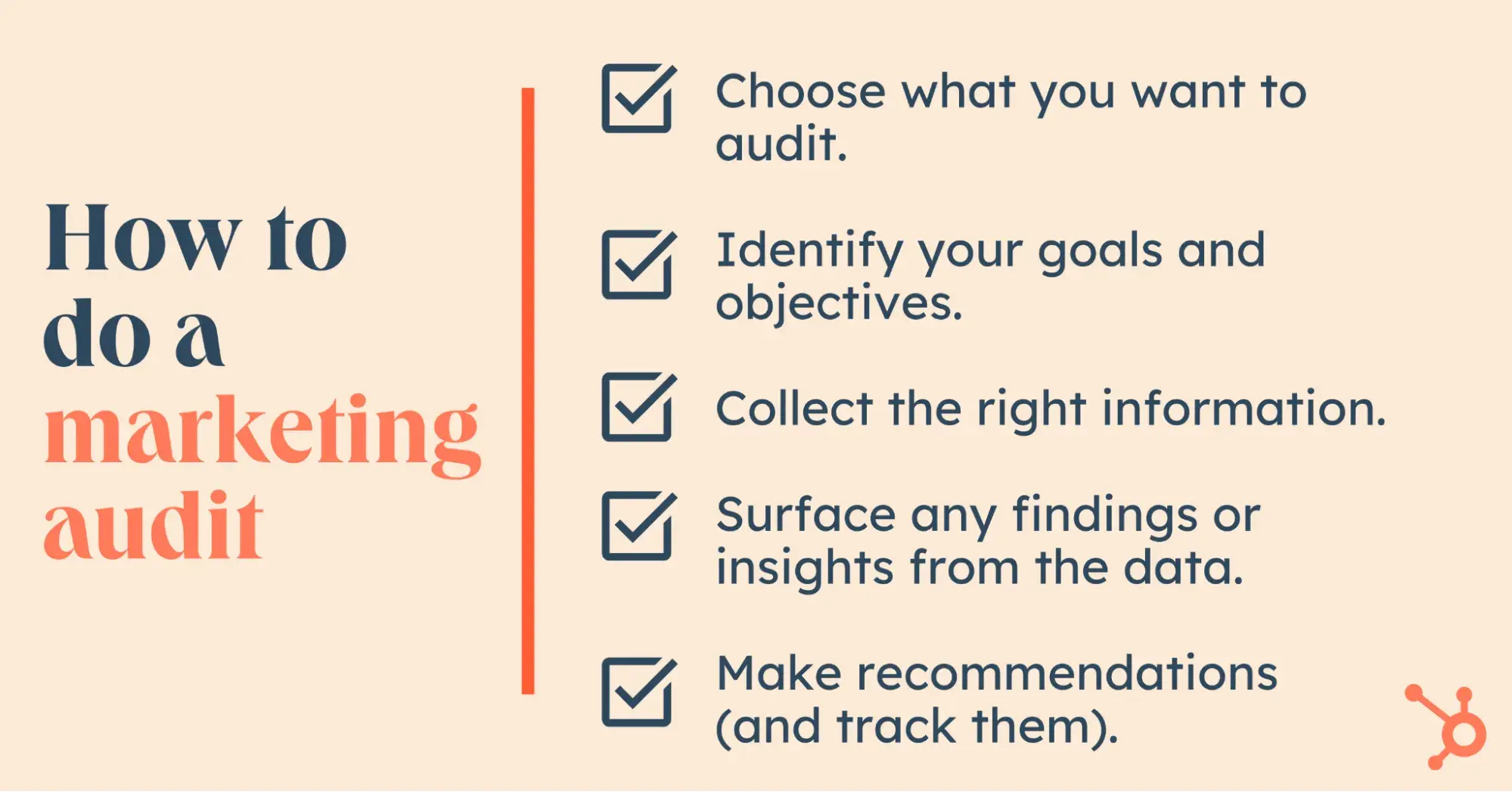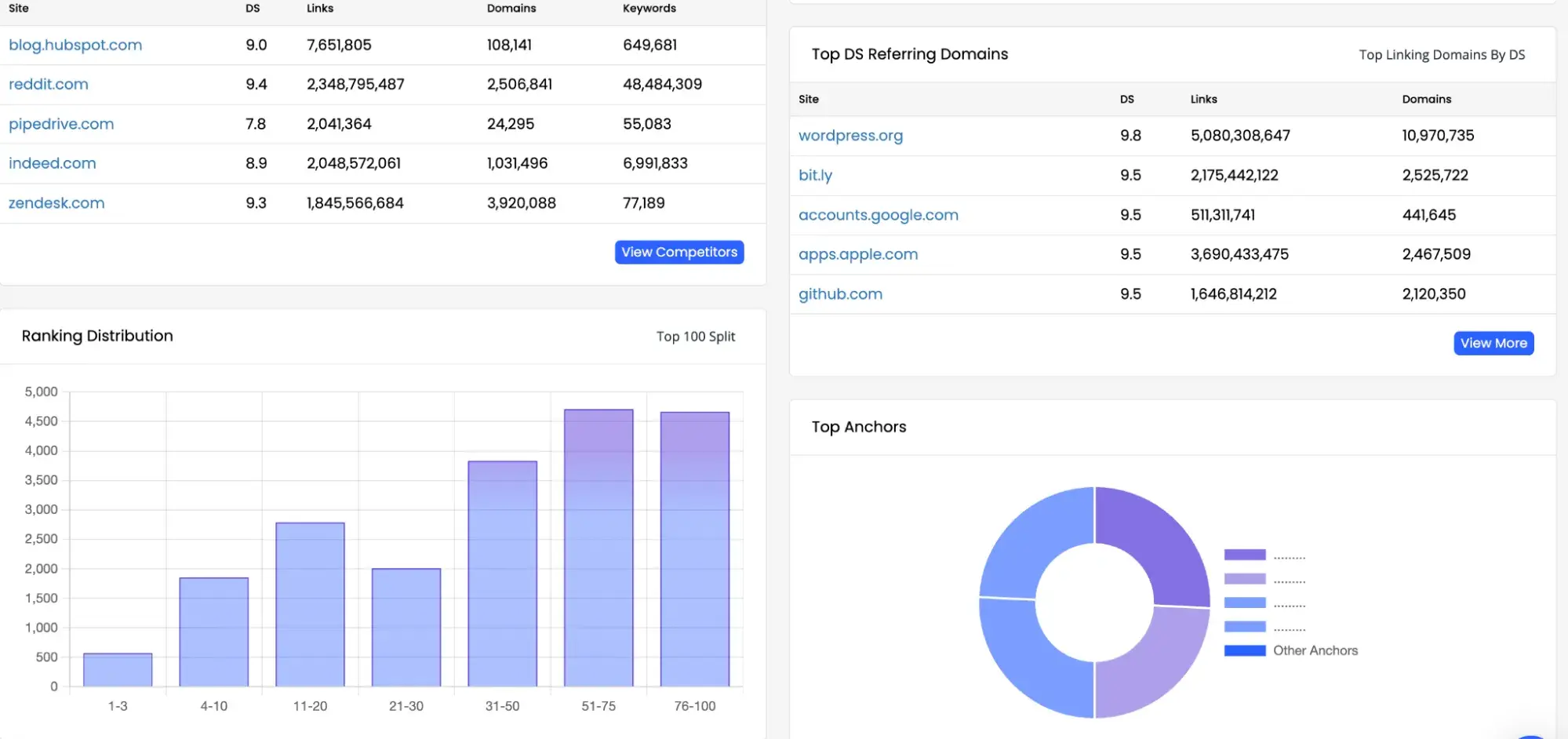In this piece, we'll take a closer look at marketing audits, the best time to conduct one, and a few best practices to pull one off.
Table of Contents
What is a marketing audit?
A marketing audit identifies the biggest strengths and weaknesses of your current strategy. It highlights what plans, processes, and practices are most effective at meeting goals. Just as importantly, it builds a foundation for future decision-making by identifying opportunities, gaps, and areas for improvement.
To get the best results, your marketing audit should be objective, systematic, and recurring.
- The objective is to ensure it's free of bias.
- A systematic approach ensures your audit is structured, organized, and measurable.
- A recurring audit helps you discover and address problems early on.
Keep in mind that a marketing audit can encompass your entire operation or a subset of it — such as a specific campaign, process, or focus (e.g., social media marketing).
Elements of a Marketing Audit

A comprehensive marketing audit may include one or more of the following elements:
1. SWOT Analysis
A SWOT analysis outlines the strengths, weaknesses, opportunities, and threats of your marketing. Using this framework, you can take inventory of your marketing assets and roadblocks.
2. Competitive Analysis
As the name suggests, a competitive analysis takes stock of the strengths and weaknesses of your competitors. It puts a magnifying glass on their products, prices, marketing strategies, campaigns, and target audience.
3. Market Research
Even if you think you know your customers through and through, market research can reveal even deeper insight into their needs, preferences, motivations, and behaviors. On top of that, you can tap into emerging trends and new opportunities in the marketplace, helping you stay ahead of the curve.
Who does a marketing audit?
It’s common for companies to outsource marketing audits to a third party. This is for a few reasons.
Firstly, it’s time-consuming. If you don’t have a large team that has the time to dedicate days, if not weeks, to market research and internal data analyses, working with an external partner might be the way to go.
Secondly, your audit needs to be as objective as possible. If your team has been responsible for a lot of the existing marketing strategy, it might be hard to examine it without bias.
Third-party firms also have more experience conducting audits, and that experience really matters. They're often better equipped to identify best practices and opportunities for improvement and may have access to specialized tools, technologies, and research capabilities.
This doesn’t, however, mean that you cannot do a marketing audit yourself. If you have time and resources (i.e., people) you can give it a go.
Alternatively, you could also decide on a mixed approach, as Jacob Barnes, founder at FlowSavvy, suggests.
“Outsource your analysis from time to time. External audits can reiterate that your in-house team is on track and making the right moves. It also helps to reduce any biases in the assessments or conclusions,” he told me.
Pro tip: If you choose to conduct your audit internally, this market research kit can provide a great starting point.
When should I do a marketing audit?
As I mentioned above, a marketing audit should be conducted on a regular basis. After all, the sooner you capitalize on what‘s working (and remedy what’s not), the stronger your marketing plan will be.
The exact frequency of your audits depends on your organization's industry, size, and goals.
Generally, it's good practice to conduct an audit on an annual basis.
Other factors may trigger the need for an audit, including:
- Significant market changes (e.g., a new competitor).
- Lack of results.
- Notable business changes (e.g., a merger).
- Planned investments (e.g. a product launch).
Now, let's cover the steps for conducting a marketing audit and a few best practices.

How to Do a Marketing Audit [+Best Practices]
- Choose what you want to audit.
- Identify your goals and objectives.
- Collect the right information.
- Surface any findings or insights from the data.
- Make recommendations (and track them).
1. Choose what you want to audit.
As I already mentioned, your marketing audit can cover your entire operation or target a specific campaign, process, or area. Ultimately, what you choose to audit is entirely up to you and will depend on your marketing priorities.
That said, your marketing is likely comprised of interrelated components, so it can be beneficial to look at your entire conversion funnel. That’s what I heard from Arham Khan, founder and CEO at Pixated.
He said they did an audit for an ecommerce brand whose product pages were getting decent traffic, but conversions were down. The team knew immediately where the gap was: the product pages needed work.
“After our CRO experts took a detailed look, we identified the problems. Their product descriptions read like bad novels, and the ‘buy’ buttons got lost in the clutter. We took things back to basics and simplified it. Punchy product descriptions replaced the waffle, we brought the product images into focus, and made those call-to-action buttons impossible to miss,” said Khan.
The results spoke for themselves: product page views jumped 28%, and conversions climbed 32% in just a few weeks.
2. Identify your goals and objectives.
Want to know which of your social media campaigns are performing well? Or how your content strategy stacks up against your competitors? Or, maybe, you want to refresh your branding or customer personas.
Start by picking an objective that will serve as the “North Star” for your audit. Next, break down your object into measurable goals.
For example, suppose your main objective is determining which social media channels provide the best engagement. In that case, your goal might be, “Meet a minimum quota of 200 new followers per month on TikTok.” Then, your marketing audit would put this to the test.
3. Collect the right information.
Now that you have well-defined and measurable goals, the next step is gathering information. This can come from a number of sources — such as campaign metrics, website traffic, social media metrics, and marketing spend.
For instance, if you're tracking the effectiveness of a specific campaign, HubSpot users can access a wealth of campaign data via the marketing analytics dashboard. From here, they can direct their marketing budget toward their most successful efforts.

You can also gather data from external sources like market research reports, industry benchmarks, and competitor analysis — but ensure the data is reliable and accurate.
Will Hatton, founder & CEO of The Broke Backpacker, thinks that competitive analysis is a must.
“Think of it as having your rival's playbook. You can see their keywords, what type of content they are creating, and which social media platforms they are getting the most hits on,” says Hatton.
He added that you might notice one of your competitors is crushing it on Instagram with their stunning display of travel photos. And that is a very big clue that you can take full advantage of.
Pro tip: Once you've gathered the data, organize it in a way that is easy to analyze and reference later. You may want to create charts and graphs, and consolidate data into a single document.
4. Surface any findings or insights from the data.
How you evaluate your data depends on the goals of the audit. For instance, you might perform a competitive analysis if you're looking to evaluate your pricing strategy against your competitors.
Document the results or findings from this step so you can make effective recommendations down the line.
5. Make recommendations (and track them).
Lastly, make recommendations for improving your marketing strategy — such as readjusting your messaging, marketing channels, or spending.
For example, if you discover your Facebook advertising strategy isn't capturing enough leads, a recommendation might be to redirect that spend to another channel.
After you make these adjustments, monitor the results to determine their effectiveness. This involves tracking key performance indicators (KPIs) and making changes as needed.

Marketing Audit Example
Let’s imagine I work at a SaaS company that sells a CRM.
Here’s the fictional setup: Despite investing significant resources into lead generation, we’ve seen a drop in new customer signups over the past six months. Conversion rates from website traffic to trial signups have declined by 25%, and churn rates among new customers have increased.
My best guess is that the issue lies somewhere in the marketing strategy or its execution. My team and I decided to conduct a marketing audit to get to the root cause.
Step 1: Defining the goals and scope.
My objective is to improve my conversion rate and extend my new customers’ lifetime value.
As you can imagine, there might be a lot of factors contributing to this state of things, so I need to decide which areas I’m going to investigate.
I could decide to focus on the following:
- Blog content.
- Email marketing.
- Social media.
- Website copy.
This is going to be the scope of my audit.
Step 2: Collecting data and evaluate your marketing strategy
The basis of any marketing audit is data. To analyze what’s working and what isn’t, I need to have the tools that will collect it for me.
So, as far as blog content and landing pages are concerned, I could turn to Google Search Console and Google Analytics. Among others, I could also check if the reason for a drop in signups is due to an overall traffic drop for my domain (for example, due to search rankings going down).
If I’m going to dive into my on-site content analysis, I could also set up a session recording tool. This would help me see if people aren’t scrolling down beyond the above-the-fold of a landing page.
Or, maybe, an article on “The best strategies for successfully implementing a CRM” that used to be the number one in Google has dropped to the 12th position. Let’s say after watching a dozen or so recordings, I notice that people no longer read past the introduction.
I verify that, in the meantime, my competitors wrote a lot of high-value content on the topic, including expert roundups, which have outranked you since they follow EEAT guidelines.
For social posts, I’d look at likes, comments, and click rates in the platform’s own reporting tools or a social media management platform.
Meanwhile, for email marketing, I’d have to turn to my CRM/marketing automation tool to verify open rates and click rates. Perhaps I’ll see that people drop out at a specific stage of an email marketing sequence, or another illuminating behavior pattern.
In my audit, I could also ask customer support to send over answers to any customer churn surveys they’ve run. With this information, I notice that many clients who had a short lifetime value mentioned that a feature they wanted to use was too complex. And so, they decided to leave my company’s tool for a competing solution.
Step 4: Creating benchmarks for marketing performance.
At this stage, I take my findings and cross-reference them with industry standards to get a sense of how well others are performing. I could also use a tool like KeySearch to get benchmarks for those who publish in the CRM space.

Daniel Vasilevski, director and owner at Bright Force Electrical, told me that the practice that he always follows during every audit is benchmarking the marketing performance against competitors. “Without that, there is no way to know if our efforts are working or if we are falling behind,” he said.
He told me that most marketers assume that a marketing strategy is working just because it brings in leads, but if a competitor is attracting twice as many with the same budget, that is a problem.
Benchmarking identifies where you are outperforming others and where you need to improve.
“If we see that competitors have stronger rankings in local search, higher engagement on social media, or better ad conversion rates, we know exactly what to work on. Without these comparisons, decisions are made blindly, and that may lead to wasted marketing spend,” Vasilevski added.
Pro tip: Bear in mind that you need to define your competition correctly. If you’re not an enterprise, defining Zendesk or HubSpot as your main competitors will only lead to frustration, as you don’t have the market share or budget to win the fight for clients.
The next two points will help you define your most suitable competitors.
Step 5. SWOT analysis
As I now have a lot of data on my business (both past and present) and these initial benchmarks, it’s time to run a SWOT analysis. Here’s a quick overview of what it could reveal.
Strengths
- Established brand presence. The brand is a recognized name in the SaaS industry, with a history of reliable service.
- Steady marketing budget. The company consistently invested in marketing activities that brought results.
- High-quality product offering. The CRM product is known for its robust features and industry-specific solutions, with many positive reviews on Capterra and G2Crowd.
- Experienced team. Me and my fellow marketing team members have experience running marketing analyses. I also have access to advanced analytics tools, so finding relevant data isn’t a problem.
Weaknesses
- Lack of updated strategies. My marketing strategies may be outdated, as I haven’t revisited them in recent years. I’m still dedicating the same budget to marketing activities, but some of the strategies might not be as effective as they used to be.
- Lack of a social media specialist on board. The person who was responsible for managing my social media channels left the company, and I haven’t found a replacement yet. It’s now managed by a few team members, but no one can dedicate their full attention to it.
- Limited customer feedback integration. Insufficient use of customer feedback to refine the product and marketing messaging.
- No updated website. We introduced a few new features but failed to communicate them in the website copy.
Opportunities
- Emerging markets. I’ve noticed that I’m getting more and more clients from the APAC region. This might hint that global expansion could be the way to go.
- Content optimization. Revamping the website content and trial signup process could engage more potential customers.
- Customer retention programs. Developing onboarding and engagement strategies has the potential to reduce churn and increase lifetime value.
- Partnerships. I want to explore how collaborating with complementary SaaS products for cross-promotions and bundle offerings could boost sales.
- AI and personalization. Using AI-driven tools for personalized marketing and improving customer experience could fix my current issues.
Threats
- Competitive landscape. Competitors may be more agile in adapting to customer needs or launching new features.
- Economic uncertainty. External economic factors may reduce customers’ willingness to spend on CRM solutions.
- Changing customer expectations. A shift in customer needs and most important features can make current marketing efforts ineffective.
- Market saturation. Intense competition in the CRM space can make it harder to stand out.
Step 6. Summarizing your key findings and recommendations
As you wrap up your marketing audit, make sure to write an Executive Summary on top and a section on Key Audit Findings, along with recommended actions.
In my example, I have found the following issues:
- Drop in conversions from the blog due to outdated content which is no longer useful. Higher-quality, more comprehensive content from competitors has been published since my last content update.
- The website copy isn’t up to date – it lacks a clear value proposition. The “Product” page doesn’t mention all the existing features. My lower conversion rates might be caused by clients turning to a competitor, as they can’t find information on a must-have feature they’re after.
- Social media profiles aren’t looked after – comments from prospects appear on my social media channels but no one replies to them, as I don’t have a dedicated social media specialist on board.
Recommended actions:
- Updating blog content with expert-level insights.
- Updating product pages to reflect my CRM’s features.
- Using my SWOT analysis to update my homepage and underline my platform’s and team’s unique qualities.
- Hiring a social media specialist or working with a contractor who’ll not only post relevant content but also reply to customer queries on time.
Marketing Audits Should Be a Recurring Thing
My biggest takeaway after working on this piece is the reminder that no strategy is set in stone. Just because something brought results for a few months doesn’t mean it will work equally well in a year – or even three months. As the business environment changes, so should my marketing strategy.
That’s why I think running a marketing audit is vital — especially if you’re seeing a performance drop. The audit doesn't always have to be robust. You can focus on one specific problem only.
The good news is that the more frequently you audit your existing strategy, the fewer issues you’ll find – and the faster you’ll be able to resolve them.
Editor's note: This post was originally published in May 2023 and has been updated for comprehensiveness.
Marketing Strategy







![The state of inclusive marketing in 2025 [new data + expert insight]](https://53.fs1.hubspotusercontent-na1.net/hubfs/53/inclusive-marketing-report.webp)
![How marketers are navigating a possible recession (and advice about what you should do during it) [new data]](https://53.fs1.hubspotusercontent-na1.net/hubfs/53/image12-May-27-2025-02-18-19-8390-AM.png)



![Cultural Marketing: What It Is & How to Do It The Right Way [According to Experts]](https://53.fs1.hubspotusercontent-na1.net/hubfs/53/Untitled%20design%20-%202025-04-03T163531.949.jpg)